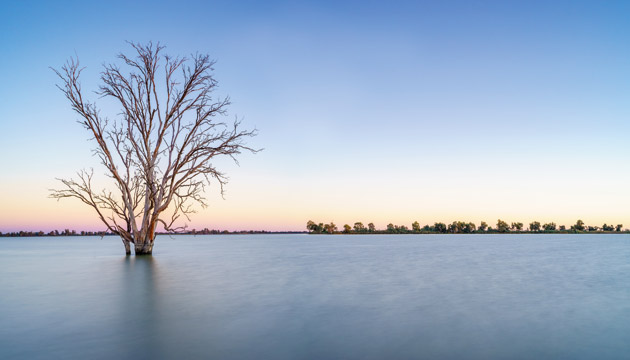A 20-year vision has brought water to a long-dry lakebed in south-western New South Wales.
Story and photo by James Carey
The gentle lap of water on the shore of Paika Lake is broken only by the chatter of the banded stilts, their long pink legs probing the muddy shallows searching for dinner. The recently planted native rushes and reeds sway in the fresh westerly breeze. This is a far cry from the arid dust-laden paddock that once stretched out in front of Dianne Williams, the owner of Paika station, as she contemplates the remarkable journey to get here. “There were times when locals would come up to me and say they have never seen water in the lake. I would quickly reply, ‘Well unless you are over 100 years old you wouldn’t have’,” Dianne says.
Paika Lake, Cherax Swamp, Hobblers Lake and surrounding wetlands are part of the Murrumbidgee River system in south-western New South Wales. In 1908 the lakes were disconnected from the Lowbidgee floodplain, when levees were constructed to concentrate water on the most productive land. Eventually Paika Lake and the surrounding wetlands dried up. As a consequence, “the health and diversity of plant and animal life dwindled, the river red gums that fringed the wetland had stunted or were near death, and the native seed bank was all but gone,” Dianne says.
In 1997 the Williams Family bought part of Paika Station. In the years that followed, drought was a constant reminder of how precious water was to the land. Dianne remembers when the dry lakebed was so fragile and could not be stocked for fear of losing all the soil. She says the westerly winds would swirl through the parched property, stripping it of life. “I remember years and years of shovelling buckets of dirt off the veranda,” she says.
Sue and Peter Morton, owners of the adjacent station, shared with Dianne a desire to restore water to the land. The Morton family has been farming for three generations in the area and Peter’s commitment to restoration started as a boy collecting bird eggs with his father. Little did he realise this hobby would one day result in him bringing thousands of birds to a lake that had been dry for more than a century.
This story excerpt is from Issue #111
Outback Magazine: Feb/March 2017










